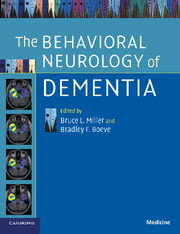Book contents
- Frontmatter
- Contents
- List of contributors
- Section 1 Introduction
- Section 2 Cognitive impairment, not demented
- Section 3 Slowly progressive dementias
- 18 Semantic dementia
- 19 Progressive non-fluent aphasia
- 20 Cognition in corticobasal degeneration and progressive supranuclear palsy
- 21 Cognitive and behavioral abnormalities of vascular dementia
- 22 CADASIL: a genetic model of arteriolar degeneration, white matter injury and dementia in later life
- Section 4 Rapidly progressive dementias
- Index
- References
18 - Semantic dementia
Published online by Cambridge University Press: 31 July 2009
- Frontmatter
- Contents
- List of contributors
- Section 1 Introduction
- Section 2 Cognitive impairment, not demented
- Section 3 Slowly progressive dementias
- 18 Semantic dementia
- 19 Progressive non-fluent aphasia
- 20 Cognition in corticobasal degeneration and progressive supranuclear palsy
- 21 Cognitive and behavioral abnormalities of vascular dementia
- 22 CADASIL: a genetic model of arteriolar degeneration, white matter injury and dementia in later life
- Section 4 Rapidly progressive dementias
- Index
- References
Summary
Introduction
Semantic dementia (SD; also known as progressive fluent aphasia) is regarded as a part of the spectrum of non-Alzheimer dementias that produce selective atrophy of the anterior temporal and/or orbitomedial frontal lobes; these conditions are referred to collectively as either the frontotemporal dementias (FTD) or frontotemporal lobar degeneration (FTLD) (Neary,1994; Neary et al., 1998). Although previously thought to be rare, FTD in fact has about the same prevalence as Alzheimer's disease (AD) below the age of 65 (Ratnavalli et al., 2002). Three clinical presentations of FTD are commonly described: a behavioral variant (bv-FTD), and two language variants, SD and progressive non-fluent aphasia (PNFA) (Hodges and Miller, 2001a,b). Since the mid 1990s, research on SD has produced a great deal of information about the clinical and neuropsychological features, progression, anatomy and neuropathology of the condition, which we attempt to review and synthesize here.
Early history
Although the term “semantic dementia” is recent (Snowden et al., 1989), the syndrome has been recognized under different labels for over a century. Between 1892 and 1904, Arnold Pick (1892, 1904) reported a series of remarkable cases characterized by progressive amnesic aphasia and changes in behavior; at autopsy these patients had marked atrophy of the left temporal lobe. Pick was perhaps the first neuroscientist to draw attention to the fact that progressive brain atrophy may lead to focal symptoms.
- Type
- Chapter
- Information
- The Behavioral Neurology of Dementia , pp. 264 - 278Publisher: Cambridge University PressPrint publication year: 2009
References
- 2
- Cited by



